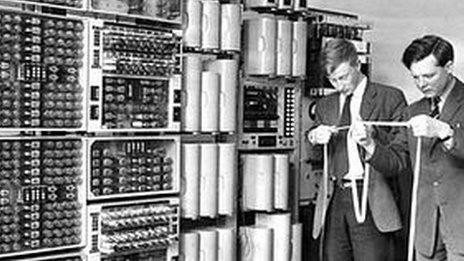Dick Barnes, pioneer behind oldest working computer, dies
- Published

One of the co-designers of a machine later recognised as the world's oldest working digital computer has died.
Richard "Dick" Barnes helped to create the Harwell Dekatron, which was first put to use in 1951 by Britain's fledgling nuclear research establishment.
He was also involved in the 2.5-tonne machine's restoration, which saw it switched back on in 2012.
Mr Barnes died aged 98 on 8 April, The National Museum of Computing said., external
He and two colleagues, Ted Cooke-Yarborough and Gurney Thomas, began their work on the Harwell Dekatron in 1949.
It was initially used by the Atomic Energy Research Establishment in Oxfordshire, where its tasks involved solving equations used to design the structure supporting the world's first commercial nuclear reactor at Calder Hall.
'Witch'
In 1957, the computer was acquired by Wolverhampton and Staffordshire Technical College.
It was used to teach computing there for 16 years and earned the nickname "Witch", or "Wolverhampton Instrument for Teaching Computation from Harwell".
"All the early computer designers faced the problems of storing data, so we selected dekatrons, a ready-made storage device for one decimal digit," Mr Barnes said in 2012.
Dekatrons were gas-filled tubes that were used as counting devices in some early digital computers. Rows of them could be used to store numbers in the computer's memory so that calculations could be carried out.
Kevin Murrell who discovered the computer explains how it was brought back to life
In November 2012 the machine was successfully switched back on after a three-year restoration project.
The revived machine functioned as planned, which is to say, very slowly.
It could take up to 10 seconds to multiply two numbers - but Mr Barnes and his co-designers had wanted a machine that could run continuously, not necessarily quickly, in order to be useful.
Indeed, it was known to calculate continuously for periods of up to 80 hours.
Delwyn Holroyd, of the Harwell Dekatron restoration team, said Mr Barnes had taken "a keen interest" in the project.
"Dick was responsible for the complex relay logic, which he designed on paper without the benefit of the tools we take for granted nowadays and with very little prior art to draw upon," he said.
"The compactness, elegance and reliability of the resulting design is a fitting tribute to his skill."
- Published24 January 2013
